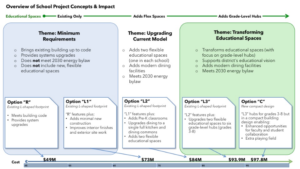 The School Committee, School Building Committee and Board of Selectmen recommended that voters approve school project Option L3 or Option C at the June 9 Special Town Meeting, while selectmen also included Option L2.
The School Committee, School Building Committee and Board of Selectmen recommended that voters approve school project Option L3 or Option C at the June 9 Special Town Meeting, while selectmen also included Option L2.
Options R, L1 and L2 do not provide the hubs for grades 3–8 that educators have deemed crucial for effective and flexible teaching and learning today, although L2 offers two “flex spaces.” Cost estimates put the L-shaped Option L3 at $93.9 million and Option C, the compact design, at $97 million.
More information:
-
- Drawings of the six school options along with costs and tax impacts for each
- A chart comparing the features and costs of the options
- The Finance Committee’s updated tax impact projections and comparisons to other area towns
[tcpaccordion id=”17948″]
In a paper poll at its meeting on May 30, concepts L3 and C were recommended by all 16 SBC members and liaisons in attendance (plus member Peter Sugar, who submitted a written response due to his planned absence). Five of the 16 additionally voted for concept L2 as a third recommendation, and one member/liaison voted to recommend all five concepts.
There was little discussion of the reasons for members’ choices except to say that they reflected the guiding principles they adopted last fall after receiving input from the public, other town officials and educators. SBC members had the option of including written comments on their ballots, but those comments were not made public.
Selectmen reject two of the concepts
The Board of Selectmen recommended against Option R as not meeting the town’s needs. “The repair-only option does not seem to me to meet the core mission of what we need to accomplish as a town with this school project,” Selectman James Craig said at the board’s May 21 meeting. “I think we’re well beyond just a repair option, and this does not meet our educational values or our environmental values. I just can’t support the expenditure of $49 million to get us to a spot in time where we’re just treading water.”
Selectmen Jennifer Glass and James Dwyer agreed. “There is nil academic value [in the repair-only option]. I don’t think it’s a good use of money because it doesn’t give you the [return on investment] you want,” Dwyer said.
Option L1 “does not, in our judgment, provide sufficient long-term educational, environmental or financial value,” members said in a May 23 statement. “We believe that the remaining school building concepts (L2, L3 and C) are all reasonable and viable plans that will support, to differing degrees, the long-range needs of our school and community.”
Selectmen also strongly supported the Finance Committee’s recommendation to stay within the town’s statutory debt limit and worried about the substantial tax increase that residents will see.
“I worry about how this tax burden is going to change our community—who sticks around and who leaves,” Dwyer said. “Do we become a ‘graduate and evacuate’ like some of our other towns, where they move in for schools that are awesome and then they leave? The community deteriorates and people are not here for the right reasons. They’re not here for Lincoln values; they’re just here to cash in and cash out on the schools.”
The town’s debt stabilization fund may provide some cushioning, and there are some tax relief programs available to qualifying residents, “but we should look to see if there are any other ways to soften what’s going to be a dramatic tax impact, whatever options gets voted on,” Craig said.
“We want to assure the town that the board is mindful of the magnitude of the financial investment the town is considering,” selectmen said in their joint statement. “Each individual will need to consider and answer the questions of personal affordability and up-front cost vs. long-term value.”
Other committees weigh in
“Options R and L1 do not provide value for money,” the School Committee said in a short May 24 statement. “Options L3 and C are critical for providing 21st-century education, and the School Committee is most excited about the educational value from Option C.”
Earlier last month, the Capital Planning Committee also recommended either Option L3 or C, as did the Lincoln School Foundation this week. The Finance Committee stopped short of advocating any particular option, though members recommended against Option FPC (which is no longer on the table) because it would require borrowing more than the town is allowed to under state statute without a special exemption.


